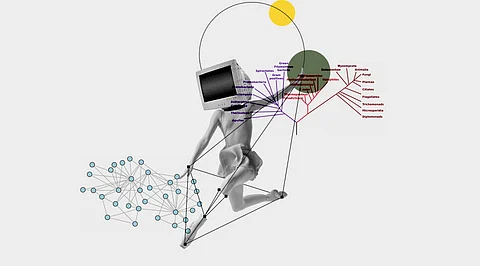

In the ever-evolving landscape of artificial intelligence and machine learning, a powerful paradigm known as Geometric Deep Learning (GDL) is gaining prominence. Rooted in graph theory and geometry, GDL provides a transformative approach to analyzing data with complex relationships, such as social networks, molecules, and 3D objects.
At the heart of Geometric Deep Learning lies the concept of graphs. Graphs, consisting of nodes and edges, model relationships between entities. GDL leverages this structure to capture intricate dependencies in data that traditional deep-learning models struggle to address.
GDL operates in both spatial and spectral domains. Data and their relationships are directly encoded in the spatial domain in a graph. In the spectral domain, graph signals are transformed into a frequency space, enabling the application of signal processing techniques.
One of the prominent applications of GDL is in the analysis of social networks. By considering individuals as nodes and relationships as edges, GDL can unveil hidden patterns, identify communities, and predict behaviors in social interactions.
Geometric Deep Learning excels in 3D object recognition and analysis. GDL enables machines to understand intricate object shapes and structures by representing objects as graphs and considering geometric properties.
In the field of chemistry, GDL holds promise for drug discovery. Molecules can be represented as graphs, allowing GDL to predict molecular properties, optimize drug candidates, and accelerate drug development.
GDL thrives in scenarios with limited labeled data. It incorporates information from labeled and unlabeled data points, making it ideal for semi-supervised learning tasks where labeled samples are scarce.
Despite its potential, GDL presents challenges such as scalability and interpretability. However, ongoing research addresses these concerns with advancements in scalable graph algorithms and visualization techniques.
Various libraries and frameworks, such as PyTorch Geometric and GraphSAGE, are dedicated to Geometric Deep Learning. These tools empower researchers and practitioners to implement GDL algorithms effectively.
GDL often collaborates with traditional deep learning techniques, leading to hybrid models. This fusion enables the strengths of both paradigms to address complex tasks efficiently.
Geometric Deep Learning's ability to model complex relationships and structures sets the stage for AI's evolution. From healthcare to finance, its applications are vast, offering a new lens through which to process and understand intricate data.
As AI advances, Geometric Deep Learning emerges as a pivotal force that bridges the gap between traditional deep learning and complex data relationships. Its ability to handle graphs and spatial domains opens doors to many applications across diverse fields. With ongoing research, innovative tools, and a growing community, Geometric Deep Learning holds the potential to reshape the AI landscape, paving the way for more accurate predictions and profound insights into the intricate world of data.
Join our WhatsApp Channel to get the latest news, exclusives and videos on WhatsApp
_____________
Disclaimer: Analytics Insight does not provide financial advice or guidance. Also note that the cryptocurrencies mentioned/listed on the website could potentially be scams, i.e. designed to induce you to invest financial resources that may be lost forever and not be recoverable once investments are made. You are responsible for conducting your own research (DYOR) before making any investments. Read more here.
